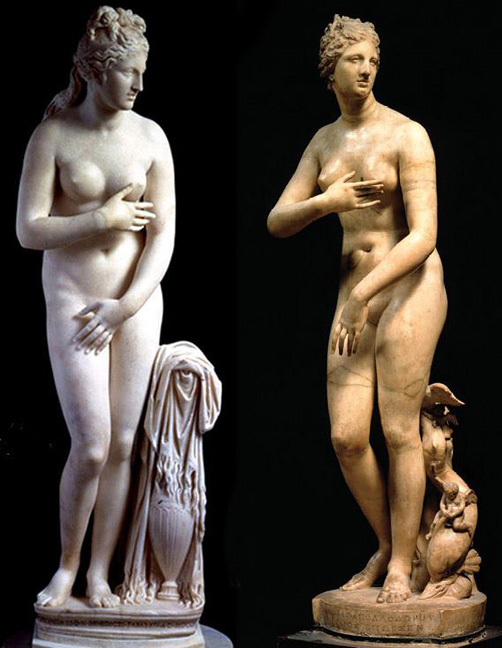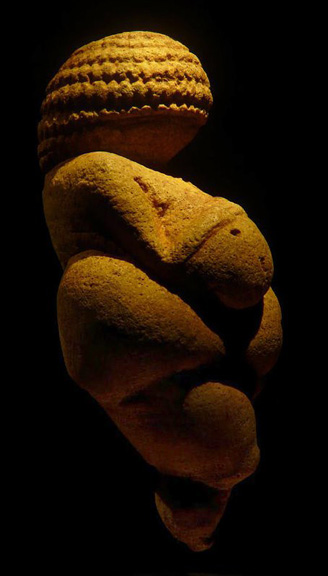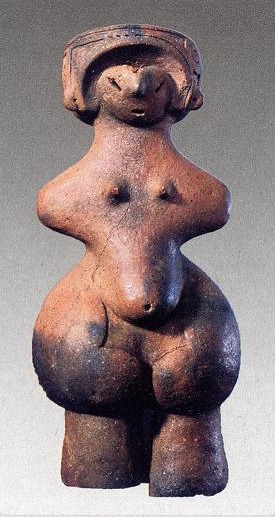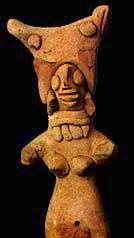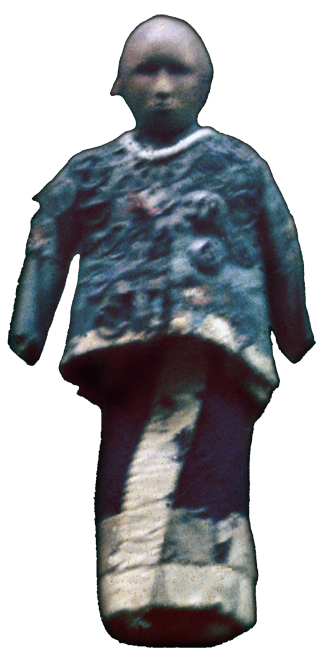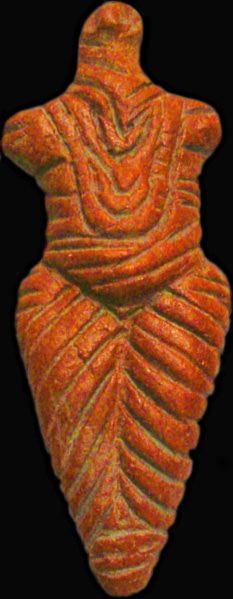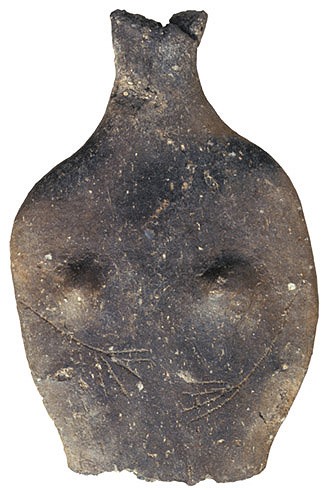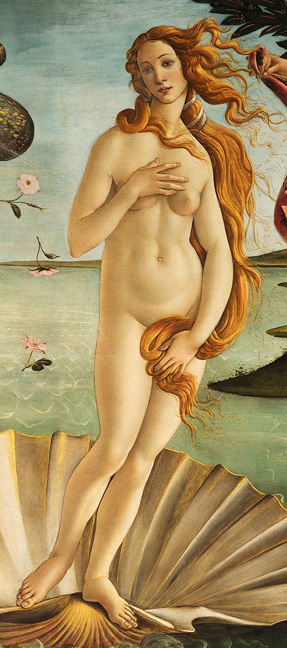They are not "Venus" figurines
© 2020 Max Dashú
The language we use matters, and images matter very much
I’ve spent fifty years studying the cultural record, searching for societies where women were free, and attempting to decolonize the history (and myths about history) that have been handed down as “truth” in the narratives of “Western Civilization” (and other patriarchies). Scanning through archaeological reports, I found that the farther back in time I looked, the more female figurines appeared in the excavations. In fact, these ancient statuettes—in stone, ivory, bone, and ceramic — turned out to be the central icons of the paleolithic and neolithic. They are the earliest human representations, and they are overwhelmingly female. I created the Female Icons, Ancestral Mothers poster in 2008 (shown below) to demonstrate that the global scope of these ancient female icons, from the paleolithic to recent times.
It took decades of digging through obscure specialist journals to find out how global this phenomenon was. Caught up in their search for rulers, chieftains, and weapons, writers and editors disregarded this female iconography. They often deemed the cultures where the female icons were prominent to be unimportant. They commonly dismissed the small female icons dismissed as toys, “dancing girls,” and “concubines,” and most commonly of all, as “fertility idols.” Even now archaeologists and other academics persist in reducing them to this reductive stereotype, which flattens out a richer examination of their cultural and spiritual significance. And it is tainted with the anti- “idolatry” prejudices of patriarchal religions.The term “Venus figurine” is also widely used, which imposes an alien interpretative framework, not only because of its eurocentrism, but because it projects a narrow presumption of “sex object” onto iconography that has a far broader range of meanings and ceremonial uses. Some will say, “But Venus was a goddess — what’s wrong with that?” Few people are even aware that the naming itself originates from the Marquis de Vibraye’s sardonic description of a small paleolithic statuette found in 1864 on his Laugerie-Basse estate in Dordogne. The classically-educated aristocrat called her a "Vénus impudique,” seeing her as “immodest” in contrast to the Roman archetype of Venus Pudica.
The mammoth-ivory paleolithic icon of Laugerie-Basse, France (8 cm.) You’ll have seen some of the many statues of Venus covering her genitals with one hand and her breasts with the other in a gesture of shame. In fact, pudica translates to “shame” as well as “modesty,” and ultimately the etymology goes back to “shrinking,” as Venus visibly does in the statues. The word pudendum comes from the same Latin root pudenda (“that whereof one ought to feel shame”), which historically was used far more commonly of the vulva than of male genitalia. These icons of a far more ancient era represent the opposite of that mentality of a patriarchal male gaze. They are self-contained and potent, having grown out of an entirely different cultural reality.
Two Roman sculptures of Venus Pudica, who embodies shame and fear The modern classifications foreclose consideration of the real significance of the female icons. They fail to address the probability that they represented female ancestors, as comparison with more recent examples would suggest. They fail to consider the ceremonial context of the figurines, or their connective and collective valence, in contrast to the social hierarchies that so many anthropologists were looking for.
She of Willendorf, by far the most famous of these ancient icons The patriarchal assumptions in “processual” archaeological analysis have cast a long shadow over interpretation of the ancient icons. They never attempt to address the existence of Indigenous matricultures, much less the importance of matrilineal ancestors in those societies, in ceremony as well as iconography. Instead, the prevailing nomenclature imposes a lens that is both patriarchalizing and eurocentric. They present us not only with “the Venus of Willendorf,” but also the “Venus of Curayacú” (Peru), “Venus of Kondon” (Manchuria), “Jomon Venus” (Japan), and countless others. (While repudiating this modernist interpretatio romana, I must credit the Italian scholars who, like many Eastern Europeans, have been far more willing to acknowledge the sacrality of the ancient female icons than their counterparts in Anglophone academia, in the US, UK, Australia, etc.)
A net search shows this figure is often described as "the Jomon Venus" But while it’s necessary to analyze the assumptions embedded in the discourse about the ancient icons, that is secondary to making the full archaeological picture known and visible to the public. Our task is to restore women to cultural memory, to learn and reveal what has been hidden from view. It is not about high theory or abstruse terminology. This study of the disregarded female icons leads us into revelatory litanies of placenames and cultural horizons: Badarian, Naqada, Halafian, Chasseyan, Yarmukian, Saladoid, Barracoid; Harappa, Mohenjo-Daro, Kulli and Merhgarh; Niuheliang, Jomon, al-Ubaid, Samarra and Hassuna, Be’ersheva; Chalcatzingo, Las Bocas, Tlatilco, Chupícuaro; Nicoya-Guanacaste; Valdivia, Marajó and Tapajós, Condorhuasi; Anau, Kultepe, and all the other Tepe-mounds of Iran and Turkmenistan, the tells of Iraq and the Levant.
From Harappa, Pakistan, early 3rd millennium bce Going further back in time, we find Hohle-Fels, Dolni-Vestonice, Laussel, Brassempuy, Balzi Rossi, Chiozza, Savignano. Yes, of course, there is Willendorf, and also Kostienki, Gagarino, and Mal’ta. Even earlier come the stone figures of Tan-tan in Morocco, and Berekhet Ram in Israel/Palestine. The well-known artifacts of Çatal Höyuk and Hacilar are supplemented by lesser-known Anatolian sites like Kösk Höyuk and Bademagaci. We scan the better-known horizons of Old Europe — Karanovo, Sesklo, Cucuteni-Tripillye, Vinca — and of bronze age Mesopotamia, and of Sudan from the deep neolithic into the early centuries CE.
Sudan, circa 3000 bce, from the socalled "A-Group" Many of these heritages come to us labeled with colonial exonyms: the “A-Group” of neolithic Sudan, the “Basketmaker” culture of the ancient Pueblo, or the socalled “Fremont culture” of Utah. From Illinois to Ohio, the figurines and sites of the Mississippian cultures all got named after European settlers who took these lands: “Hopewell,” “Turner Mound,” the “Mann site.” There must be a more culturally evocative title for the tiny figurines of “Poverty Point,” Louisiana, or the large ones of the Inland Delta of the Niger in Mali. It is difficult to identify site names for those, or for their predecessors in the Nok culture of Nigeria, or the millennia-old figurines in Zimbabwe. But they exist.
From southern Ohio, the socalled "Turner Mounds," circa 500 CE One of my students asked me recently, So what should we call them then? My short answer was “female icons,” which carries the sacredness while preserving the broadest possible spectrum of meanings. That has been the simplest, clearest, and least-loaded naming that I have been able to come up with. But a multiplicity of possible names is needed, which is why I also use “ancestral mothers” or “ancestral women” or “paleolithic grandmothers.” I sometimes still say “ancient figurines” or “female figurines,” for maximum clarity about what artifacts I am referring too. The naming of "Goddess" has been much-criticized but the spectrum from "Great Mother" to "clan ancestor" is not to be dismissed, especially since some of these images are found within shrines. It will take us a while to build a common language where referents are understandable to everyone.
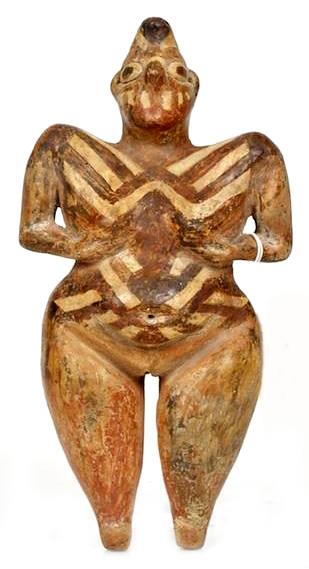
Anatolian icon from Hacilar, Turkey, more than 7000 years ago In Japan the icons are called dogu, which some translate as “dolls,” but literally means “clay figures.” Because the English word “doll” has been used dismissively for so long in archaeological texts, it raises my hackles. But the Japanese archeaologists recognize their sacral import, and have noted their placement in shrine areas of houses. After thinking about this for some time, I realized that “sacred dolls” is a descriptive name that comes up in living Indigenous contexts, whether it is the female ancestor carvings called Mwana Hiti in Tanzania, or the Odas grandmother carvings of the Lenape in North America, where women keep the doll-making tradition alive. Such icons in wood or clay wrapped with grasses and beads represent female ancestors in womanhood initiations in some parts of South Africa. They figure in prayers and eremonies for conception among the Ashanti and various other African peoples. Ceremonial use of the small icons is indicated in a great many of the ancient archeaological contexts as well, and they themselves offer a window into ritual paint-up and regalia.
Odas Grandmother doll of the Lenape people, American Indian Museum II.
Naming is so fraught. I’ve been fighting the assumptions encoded in “fertility idols” and “Venus figures” for decades. In the 70s and 80s feminists and pagans called them “goddesses” because we recognized their sacrality and potency. We fought against the enforcers who claimed that the figurines were historically or culturally unimportant, and who treated anything Goddess as a kind of heresy not to be tolerated in academic discourse.
Our definition of what Goddess is differed markedly from theirs. We embraced her as immanent, unlike the distant and disembodied transcendent god of patriarchal religions, and we saw her as a spectrum: of Being, of beings, of consciousness in everything and through the cycles of life and death. We recognized her as verb, as transformative and transforming, and not a reified thing that stood separate and apart. And we recognized her as Ancestor, as untrammeled female potency.Cucuteni-Tripillye culture, Romania, Moldova, Ukraine But this became complicated for reasons other than what the academic old guard was saying. Many Indigenous women objected to the goddess nomenclature. Some prefer to speak of spirits, who could be primordial beings or nature spirits or ancestors. The Navajo refer to “the holy people,” rather than to “gods and goddesses". And often these beings are named in kinship terms, like Our Mother, or Old Woman Who Never Dies, among the Mandan. The Shawnee revered Our Grandmother the Creator, Kokomthena, who is clearly a deity.
This takes us down so many byways of language, which is a core constituent of culture and its philosophical underpinnings. Deity, divinity, diosa, déesse, dea, dia, diva, devona, dev?, diwiya all come from a Proto-Indo-European root that means “to shine.” Goddess tacks on a Romance feminizing ending to a Germanic root which was not originally gendered as “god” has become:
There are a range of cultural approaches among the many ethnicities. In the Pueblo traditions, Spider Grandmother acts as a creator (see the writings of Leslie Marmon Silko and Paula Gunn Allen). Barbara Mann has laid out stories of co-creation by multiple beings (and this is not only true of Iroquoian traditions). She views the coalescence by the 20th century of “Creator" discourse as the product of christianizing influence. I’ve read and heard North American traditions that speak of Creator in masculine terms, but in recent decades have noticed a shift, as prayers that used to be directed to Grandfather changing to Grandfather, Grandmother, or reversed. Which is how i’ve seen it in Mapuche prayers to the Grandmothers and Grandfathers of the East, South, West, and North.
The Proto-Germanic meaning of *ghu?án and its etymology is uncertain. It is generally agreed that it derives from a Proto-Indo-European neuter passive perfect participle *??u-tó-m. This is similar to Persian word for God, Khudan. This form within (late) Proto-Indo-European itself was possibly ambiguous, and thought to derive from a root *??eu?- "to pour, libate" (the idea survives in the Dutch word, 'Giet', meaning, to pour) (Sanskrit huta, see hot?), or from a root *??au?- (*??eu?h2-) "to call, to invoke" (Sanskrit h?ta). ["God" (word) Wikipedia]
What i find significant about ghu∂án is that it spans address to divinities and to ancestors. So when we trace back to root meanings of European names for Goddess, we find animacy. (This reframing by Potawatomi botanist Robin Wall Kimmerer is most useful, since the colonialist prejudices attached to “animism” have long been problematic). There is “shining,” or there is "making offerings, invoking, calling in,” and both these sets of meaning can apply to a spectrum of beings, from divinities to ancestors to land spirits who are embodied. And there are many instances in the European cultures of that same use of kinship terms in addressing the Divine, from the Matronae and Matres stones to Y Mamau of the Welsh, a faerie naming that means “the mothers.” We can think, too, of the four dozen kinds of m?te revered in Latvia, from Z?mys M?te (Mother Earth) to the m?te of sea, forest, sand and fire.
Chasseyan culture, Paris basin, circa 4000 bce But I want to go back to the term "Venus,” and to the ways it has been used in modern times. Very little is known about archaic Venus among the Latins. No images of her survive other than the sexual / modesty polarity that the Romans (and the Etruscans too) had absorbed from the Hellenes. But the ethnic distinctions here were greater than is usually recognized. (How many people think of Saturnus as a god of agriculture, for example? He was for the Romans — very different than Greek Kronos. And who has ever heard of his wife Ops, once an important Latin goddess?) Behind Venus is Aphrodite, and behind her stands the Semitic goddess ‘Ashtart / Astarte / Ishtar. In each cultural shift she changes — in an increasingly patriarchalizing direction.
The point here is how Venus was made into a stereotype for the male gaze, and how that is not the same thing as actual female sexuality — no matter how many times they insist that it must be; that patriarchal projections are reality. This highly sexualizing stereotype didn’t stop with the Romans but was carried along in European art, through medieval and Renaissance and baroque and Romantic paintings and sculptures, as a defining way of looking at women’s bodies, of defining what women were. The male artists enthusiastically kept Venus Pudica going, hands held ineffectively over breasts and genitals, or limply reclining en déshabille, her head dropped, usually gazing down, or looking off somewhere in the distance. Only rarely does she look directly at you, as so many of the archaic figurines do, with their bold stance — their wide or fat bodies taking up space without shrinking or apology.One thing that’s striking about most of these images, whether it’s Botticelli or Rubens or Goya, is how the knees of Venus are drawn tightly together, especially when she is standing. It’s the same pose that fashion has trained women to assume. Just look at these, the defensive stance, and behind that, the fear of rape. The way so many of us were scolded into keeping our knees together, our skirts drawn down, in contrast to socialized manspreading.
"The Birth of Venus," Boticelli. As Joan Baez put it, "the girl on the halfshell" These negative encodings are cultural spells whose roots most women are totally unaware of, and yet they are deeply embedded in how we are taught to look and move and inhabit our bodies. And if we do not, there are consequences. If we do, there are other consequences. But these scripts die very hard. They’re still being propagated. They are the cultural wallpaper of the dominant society. This is supposed to be "the sexy pose," and yet it is culturally specific, far from universal, and prescriptive in ways most people have yet to recognize.
All these assumptions and projections are invoked when people refer to “Venus figurines,” even if they aren’t consciously aware of them.III.
There’s another aspect to this Venus terminology — an intensely racialized one. It was used as a racist insult and sexual mockery to describe a Khoekhoe woman, Sara Baartman, as “the Hottentot Venus.” Her captors paraded her around freak shows in England, Ireland and France. (And she was not the only Khoekhoe woman treated in this manner, only the most famous one.) She died from this very lonely and alienating captivity among hostile strangers. [I would like to credit Sid Reger for drawing attention to the contemptuous and contemptible use of “Venus” to degrade Sara Baartman, and all the other African women subjected to this abuse.]
From the late 1700s and through the 1800s, Europeans published a series of horribly offensive cartoons of South African women, contrasting them with white standards of beauty and femininity and projecting them as “savages” lacking in any right to rights, boundaries, or respect. This is what made it possible to traffic a Khoekhoe woman as an exotic “curiosity,” cutting her off from her people and country, subjecting her to abuse and mockery and misery. "Sara was literally treated like an animal. There is some evidence to suggest that at one point a collar was placed around her neck.” In 1814, she was sold to a French animal trainer:
"Georges Cuvier, founder and professor of comparative anatomy at the Museum of Natural History, examined Baartman as he searched for proof of a so-called missing link between animals and human beings. [!] After being sold to S. Reaux she was raped, and impregnated by him as an experiment. The child was named Okurra Reaux, and she died at five years of age of an unknown disease."After her death, [Georges] Cuvier dissected her body, and displayed her remains. For more than a century and a half, visitors to the Museum of Man in Paris could view her brain, skeleton and genitalia as well as a plaster cast of her body. … Cuvier interpreted her remains, in accordance with his theories on racial evolution, as evidencing ape-like traits. He thought her small ears were similar to those of an orangutan and also compared her vivacity, when alive, to the quickness of a monkey."
"Baartman lived in poverty, and died in Paris of an undetermined inflammatory disease in December 1815. Her remains were returned to South Africa in 2002 and she was buried in the Eastern Cape on South Africa's National Women's Day." https://en.wikipedia.org/wiki/Sarah_Baartman
The racist projections comparing Africans to apes were still alive in the 1930s, when the South African government confined the !Xhosa prophetess Nomtetha Nkwekwe to a madhouse, for years, in order to suppress her leadership of a liberatory African movement. In researching her story, I read that doctors at that mental “hospital” were experimenting on African women, by attempting to transplant the uteri of baboons into their bodies. And this will remind you, if you know about it, of what Dr. Marion Simms did to enslaved African women in the U.S. in the 1800s, experimental “surgeries” on their uteri, without anesthesia. This man was hailed as the father of gynecology for his torture and exploitation of the women unfortunate to fall into his hands.
The history of using “Venus” to ridicule, exploit and torment African women, is yet another argument against perpetuating use of the term “Venus figurines.” The phraseis too heavily loaded with a history of degradation and misogynist objectification. For this and all the reasons I have given above, it is not an appropriate way of naming one of the most significant global patterns of female iconography. It carries along and propagates damaging misconceptions about women and about the ancient cultures.From Kaminaljuyú, Guatemala, in a triangular seated style that has parallels from Costa Rica to Brazil to the Caribbean Islands. Large regional patterns are also visible for SW Asia or NE Africa or South Asia.
This rich cultural heritage needs to be recognized in all its diversity, and integrated into our understanding of history and spiritual culture. This iconography shares many recurrent patterns: gestures of hands to breast, hands to the belly, or tattoos, the numinous vulva, the significance of red ochre, face and body paint, among other themes.
The Female Icons poster (more info on the images here). See lively discussion of this article here. There's much more to be said on this subject, but that will have to wait for another time. Sometime in 2021, I'll upload a video of Female Icons, Ancestral Women on the Suppressed Histories Portal on Teachable...©2020 Max Dashu

